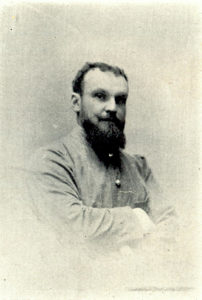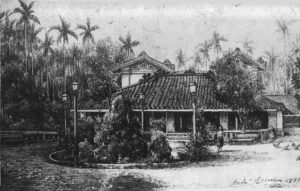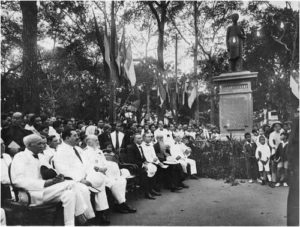
Pétrus Trương Vĩnh Ký (1837-1898)
Reminiscences by soldier, explorer and writer Pierre Sauvaire de Barthélémy (1870-1940) about his visit to the house of Vietnamese scholar Pétrus Trương Vĩnh Ký.
Petrus-Ky is one of the most distinguished Annamite pupils of the Missionary School of the Paris Foreign Missions Society. Petrus-Ky is the name which was given to him at his baptism by the Brothers, while Truong-Vinh-Ky is his Annamite name.

Pierre Sauvaire de Barthélémy (1870-1940)
He speaks fluent French and his conversation is that of a true scholar. He has retained, along with the religion of his former masters, a great gratitude for them; But I heard him utter against them a slight reproach, which I cannot deny is well founded.
At the schools of the missions, they insist on to promoting the study of Latin over the study of French; At one time, this trend went so far that, in the early days of the occupation, one could only find Latin-speaking interpreters!
If it had not been so heartbreaking for the victim, one story told about this would lead us to laughter. During the early days of our occupation, a brave sailor was ordered by his commander to hang four rebels. However, instead of four rebels, our matelot saw five Annamites gathered near the tree where the execution was to take place. “The commander is mistaken,” he said, “there is one more.” So, after having hanged the four first convicts, he set about executing the fifth. “Ego sum Petrus, Interpretus,” cried the unhappy man, defending himself. “Ah! You’ll get what’s coming to you Mr Interpretus,” grunted the sailor, hoisting the poor man into the tree alongside his compatriots. By the time the commandant returned, it was too late. The unfortunate interpreter had paid with his life for speaking only a dead language.
Fortunately, the need for the natives to speak French in order to find employment hastened the disappearance of Latin, which was of little use, and its replacement by modern languages.

Pétrus Ký teaching his students
After completing his education, Petrus-Ky began to study with care the history of his country. Today, he knows all the dialects of Indo-China and the ethnography of his country. His opinion on the indigenous natives, the Moys or Khats of the Annamite chain, is absolute. The Annamite, he adds, came from Tibet; that race is mingled with Chinese and Malay, mostly fishermen or boatmen who were brought here by the current and shipwrecked, and, deciding not to return to their own land, instead sought asylum in the Annamite villages along the coast. As for the Cambodian race, according to the opinion of our native scholar, they were the result of Hindu immigration into the region. One finds evidence of these origins in the ruins of Angkor and in the Cambodian language, where Sanskrit and Pali predominate. The indigenous people there are the Pnoms, who are settled between the Mekong and Annam. The word Pnom or Penong is Cambodian. The Penongs and the Moys are the same race, but their name changes according to whether they live in Annamite or Cambodian territory.
France, says Petrus-Ky, has an excellent influence on education in Cochinchina. At present, beside the practical French courses, the Interpreters’ College has a Chair in Chinese, currently held by our learned interlocutor, who teaches a reasoned course in Chinese language and writing.

Pétrus Ký’s house in Chợ Quán, from “Un érudit cochinchinois: Petrus J-B Truong-vinh-ky,” Extrême-Asie, 1 décembre 1925, pp 477-483
Every Annamite loves to visit Petrus-Ky’s house, so we did not forget to ask him for an invitation. Though less rich than the house of the Phu of Cholon, the house of Petrus-Ky is no less curious. One particular trinket among the many which fill its Asian interior attracted our attention: it is an ebony table with inlaid mother-of-pearl, an essentially Annamite work. The images inlaid on it depict the occupation of Annam and Tonkin by the French. In the centre of the table, our compatriots are seen at rest, sipping absinthe and gesticulating around a table; A little further away, we see a ship bringing officials from across the sea; on its deck is a table prepared with a glass and a bottle. Around these two main images, French forces are depicted fighting, chasing the Chinese from Lang Son and beating the Annamites in Hue. This simple trinket is a manifestation of the observant spirit of the Annamites. They have noticed, first of all, this typical habit we have of resting, drinking slowly around a table and discussing with great zeal things which are often indifferent to each of the interlocutors.
Among other trinkets, Petrus-Ky also possesses guns dating from the reign of Louis XV, which have been inlaid with gold by the Annamites and inscribed with dedications from one mandarin to another. It was Dupleix who first succeeded in establishing a trade flow between Indo-China, the Indies, Madagascar and the Metropolis. The dream of that great coloniser has been resumed in the present, though now through a calm internal policy by a wise government which is less concerned with opposition, permitting the accomplishment of his grand design.

The inauguration of the Pétrus Ký statue behind Saigon Cathedral in 1928
We also noted, in the living room, a fine collection of sabres of honour presented by Annamese mandarins. These sabres do not have moon images on the blade like the sabres of the Chinese, and several, in their form, suggest that they are in fact European swords which have been adorned in their own way by the natives.
After thanking our host, we were about to take his leave when he detained us for a moment. This was in order to offer each of us a copy of his Histoire d’Annam, a very interesting work which would prove very useful to us later, when we began to study this beautiful country.
“One of the most remarkable details of the character of Petrus-Ky,” said Monsieur M., the administrator who introduced us to him, “is his modesty. Despite being showered with honours, decorated with the Légion d’Honneur, the Order of Isabelle la Catholique, an award from the Pope, the officier de l’Annam, the officier du Cambodge and several other Far Eastern decorations, he remains simple, welcoming and very devoted to the European cause. But what he is most proud of is to be able to say that he is 22 times a grandfather, and that all of his children speak French.”
A good Christian, an honest father of a family, a distinguished scholar, here indeed is a result of the good efforts of the missionaries, and the gratitude he has vowed to his masters is surely the best reward they have ever obtained.
May the excellent scholar live for a long time in his quiet village of Cho-Quan and be an encouragement to the colonising efforts of the mission! But do not forget, brave Fathers, that in order to make useful auxiliaries for your compatriots, the first step of your education must be the study of French. Reserve the study of Latin only for the best of your students, who alone will be able to appreciate its literary beauty!
For other articles relating to Petrus Ky, see:
Old Saigon Building of the Week – Petrus Ky Mausoleum and Memorial House, 1937
What Future for Petrus Ky’s Mausoleum and Memorial House?
Petrus Ky – Historical Memories of Saigon and its Environs, 1885, Part 1
Petrus Ky – Historical Memories of Saigon and its Environs, 1885, Part 2
Petrus Ky – Historical Memories of Saigon and its Environs, 1885, Part 3
Tim Doling is the author of the walking tour guidebook Exploring Hồ Chí Minh City (Nhà Xuất Bản Thế Giới, Hà Nội, 2014).
A full index of all Tim’s blog articles since November 2013 is now available here.
Join the Facebook group pages Saigon-Chợ Lớn Then & Now and Huế Then & Now to see historic photographs juxtaposed with new ones taken in the same locations, and Đài Quan sát Di sản Sài Gòn – Saigon Heritage Observatory for up-to-date information on conservation issues in Saigon and Chợ Lớn.

